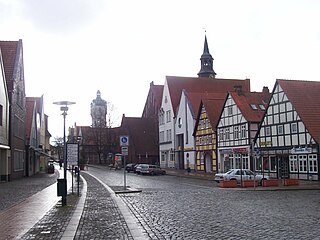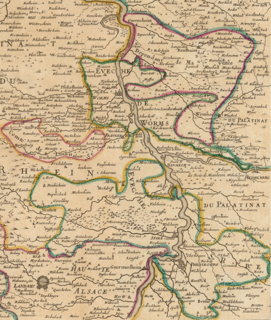Bishopric of Verden may refer to:
- Diocese of Verden, the ecclesiastical jurisdiction of the bishop of Verden
- Prince-Bishopric of Verden, the secular jurisdiction of the bishop of Verden
Bishopric of Verden may refer to:

Rotenburg an der Wümme is a town in Lower Saxony, Germany. It is the capital of the district of Rotenburg.

Verden an der Aller, also called Verden (Aller) or simply Verden, is a town in Lower Saxony, Germany, on the river Aller. It is the district town of the district of Verden in Lower Saxony and an independent municipality. The town is located in the middle Weser region on the Aller river immediately before it flows into the Weser. As a center of horse breeding and equestrian sports, it bears the nickname "equestrian town". The suffix "Aller" was introduced at a time when the name "Verden" was also common for the French town of Verdun in the German-speaking area. The town name comes from "ford" or "ferry". The town was conveniently located at a ford through the Aller river, near an important trade route.

The Prince-Archbishopric of Bremen — not to be confused with the modern Archdiocese of Hamburg, founded in 1994 — was an ecclesiastical principality (787–1566/1648) of the Holy Roman Empire and the Catholic Church that after its definitive secularization in 1648 became the hereditary Duchy of Bremen. The prince-archbishopric, which was under the secular rule of the archbishop, consisted of about a third of the diocesan territory. The city of Bremen was de facto and de jure not part of the prince-archbishopric. Most of the prince-archbishopric lay rather in the area to the north of the city of Bremen, between the Weser and Elbe rivers. Even more confusingly, parts of the prince-archbishopric belonged in religious respect to the neighbouring Diocese of Verden, making up 10% of its diocesan territory.

Bremen-Verden, formally the Duchies of Bremen and Verden, were two territories and immediate fiefs of the Holy Roman Empire, which emerged and gained imperial immediacy in 1180. By their original constitution they were prince-bishoprics of the Archdiocese of Bremen and Bishopric of Verden.

The Prince-Bishopric of Worms, was an ecclesiastical principality of the Holy Roman Empire. Located on both banks of the Rhine around Worms just north of the union of that river with the Neckar, it was largely surrounded by the Electorate of the Palatinate. Worms had been the seat of a bishop from Roman times. From the High Middle Ages on, the prince-bishops' secular jurisdiction no longer included the city of Worms, which was an Imperial Free City and which became officially Protestant during the Reformation. The prince-bishops however retained jurisdiction over the Cathedral of Worms inside the city.

Amelinghausen is a municipality in the district of Lüneburg in Lower Saxony, Germany. It is also the seat of the collective municipality (Samtgemeinde) of Amelinghausen.
The term coadjutor is a title qualifier indicating that the holder shares the office with another person, with powers equal to the other in all but formal order of precedence.
Bishopric of Augsburg may refer to:

A diocesan administrator is a provisional ordinary of a Roman Catholic particular church.
Verden can refer to:
Adaldag was the seventh archbishop of Hamburg-Bremen, from 937 until his death.

The Prince-Bishopric of Münster was a large ecclesiastical principality in the Holy Roman Empire, located in the northern part of today's North Rhine-Westphalia and western Lower Saxony. From the sixteenth to the eighteenth centuries, it was often held in personal union with one or more of the nearby ecclesiastical principalities of Cologne, Paderborn, Osnabrück, Hildesheim, and Liège.
The Vicariate Apostolic of Northern Germany, known for most of its existence as the Vicariate Apostolic of the NorthernMissions, was a Catholic missionary jurisdiction established on 28 April 1667. It belonged to a vicar apostolic in predominantly Protestant Northern Europe.

The Prince-Bishopric of Verden was an ecclesiastical principality of the Holy Roman Empire that was located in what is today the state of Lower Saxony in Germany. Verden had been a diocese of the Catholic Church since the middle of the 8th century. The state was disestablished in 1648. The territory was managed by secular lords on behalf of the Bishop of Verden. As a Prince-Bishopric of the Empire, the territory of the state was not identical with that of the bishopric, but was located within its boundaries and made up about a quarter of the diocesan area. By the terms of the Peace of Westphalia, the Prince-Bishopric was disestablished and a new entity was established, the Duchies of Bremen and Verden.

Bertold of Landsberg was bishop of Verden. He was also Bishop of Hildesheim as Berthold II.

The Diocese of Verden was a diocese of the Catholic Church. It was founded around AD 768 as a suffragan of the Archdiocese of Mainz. It was suppressed in 1648 as part of the Peace of Westphalia. The diocese was centered on the city of Verden an der Aller in what is today the state of Lower Saxony, Germany. The cathedral church of the diocese was dedicated to Ss Mary and Cecilia in 1028 but the building was only completed in 1490. The Bishop of Verden was also, ex officio, the ruler of a principality of the Holy Roman Empire — the Prince-Bishopric of Verden. The territory of the diocese was not identical with that of the prince-bishopric; while the state was located within the boundaries of the diocese, it amounted to less than a quarter of the diocesan territory. Its last bishop was Franz Wilhelm, Count von Wartenberg. Following the Thirty Years' War, Verden, along with the neighbouring sees of Minden and Bremen, fell into the hands of Protestants. Wartenberg was only able to retain the See of Osnabrück.

In the Holy Roman Empire, the Domfreiheit or Domimmunität was the area immediately around the seat of the Bishop of a cathedral and its cathedral chapter, which was managed by the Domdechant; the English term is cathedral close. This area stretched only a few hundred metres from the outbuildings of the cathedral, at most, and was usually surrounded by a fortified wall (Domburg). They belonged to the secular domain or Hochstift of the bishop.
Bishopric of Trent may refer to:

The Council of Bishops of the Serbian Orthodox Church, also known in English as the Holy Assembly of Bishops of the Serbian Orthodox Church serves by Church constitution as the supreme body of the Serbian Orthodox Church. It is the supreme organ of the legislative authority of the Church in matters of faith, worship, church order or church discipline, and the internal organization of the Church. It is also the highest judicial authority in its jurisdiction. It is convened annually in May. In case of emergency, it can also be summoned at any other time.